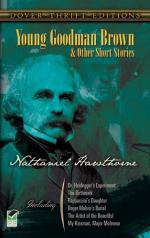|
This section contains 6,342 words (approx. 22 pages at 300 words per page) |

|
SOURCE: “The Sources of Ambiguity in Hawthorne's ‘Young Goodman Brown’: A Structuralist Approach,” in ESQ: A Journal of the American Renaissance, Vol. 26, No. 1, 1980, pp. 16-25.
In the following essay, Mosher uses a structuralist critical approach to focus on contradictions in meaning and on the reader's relationship with the narrator in “Young Goodman Brown”.
As Jonathan Culler has observed, the structuralist method, based on the linguistic model, should “account for our judgments about meaning and ambiguity, well-formedness and deviance.” The structuralist critic studies the conventions of any system that enables its signs to produce meaning or certain effects. He does not primarily study meaning or seek to formulate new interpretations; rather he examines how meaning or effects are achieved.1 In such analyses, of course, consideration of meaning cannot be ignored. Thus, Claude Lévi-Strauss, by a method that consists of “dividing the syntagmatic sequence into superposable segments, and in...
|
This section contains 6,342 words (approx. 22 pages at 300 words per page) |

|


